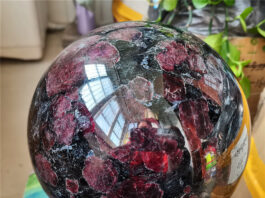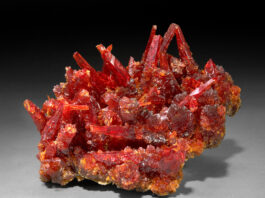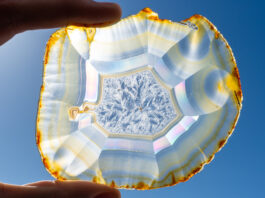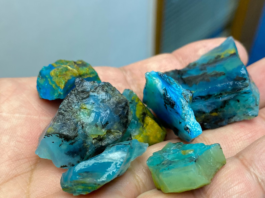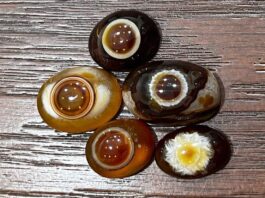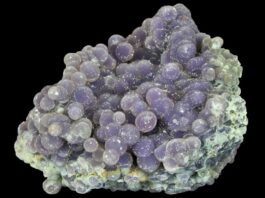Peanut Wood Jasper is a unique and visually striking variety of jasper, which is a type of chalcedony, a microcrystalline form of quartz. What sets Peanut Wood Jasper apart from other types of jasper is the presence of distinct, fossilized remains of prehistoric plant material within its dark brown to black matrix. This fossilized plant material is often mistaken for the shape and appearance of peanuts, hence the name “Peanut Wood Jasper.”


The name “jasper” is derived from the Greek word “iaspis,” which means “spotted stone,” and it is used to describe various opaque, fine-grained, and densely patterned varieties of chalcedony, typically found in a range of earthy colors.
Peanut Wood Jasper, however, is renowned for its intricate, light-colored, peanut-shaped inclusions that contrast sharply with the dark background, creating a visually captivating and almost artistic appearance. These inclusions are the result of petrified driftwood from ancient trees, which sank to the bottom of an ancient sea and became embedded in sediment. Over millions of years, the wood was gradually replaced by silica, leaving behind the unique patterns and shapes characteristic of Peanut Wood Jasper.
Peanut Wood Jasper is appreciated for its aesthetic appeal and its historical and geological significance. It is often used in jewelry, lapidary work, and as a collector’s stone, with each piece revealing its own distinct patterns and history. The exact source of Peanut Wood Jasper can vary, but it is typically found in Western Australia, near the Kennedy Ranges.
In addition to its visual appeal, it is believed by some to have metaphysical and healing properties, including grounding energy and promoting patience and endurance. Whether you’re drawn to it for its appearance or its purported properties, it is a remarkable and distinctive gemstone that has intrigued geologists, collectors, and enthusiasts for many years.
Contents
Geological origin and formation

The geological origin and formation of Peanut Wood Jasper are quite fascinating. This unique jasper variety is associated with the geological history of Western Australia and the remnants of ancient marine environments. Here’s an overview of how Peanut Wood Jasper was formed:
Ancient Marine Environment: The formation of it can be traced back to the Cretaceous Period, which occurred around 145 to 66 million years ago. During this time, the region that is now Western Australia was covered by a vast inland sea, known as the Eromanga Sea.
Fossilized Wood: In this ancient sea, various types of vegetation and driftwood, including logs and branches, were transported by water and eventually sank to the sea floor. These pieces of wood became waterlogged and sank to the sediment, where they were preserved in the anaerobic (low-oxygen) conditions of the seafloor.
Petrification: Over millions of years, these submerged pieces of wood underwent a process of petrification. Petrification occurs when the organic material is gradually replaced by minerals, primarily silica (silicon dioxide). As the wood decays, the voids left by the decomposition are filled with silica-rich solutions that harden over time, essentially transforming the wood into stone.
Fossilization of Plant Material: As the wood was replaced by silica, it retained the shape and structure of the original plant material, creating the distinctive peanut-shaped inclusions and patterns seen in Peanut Wood Jasper.
Sedimentary Rock Formation: The entire geological process took place within sedimentary rock layers. Over time, the sedimentary rocks containing the petrified wood were uplifted and exposed to the surface through geological processes, such as tectonic activity and erosion.
Today, it is found in these sedimentary rock formations in the Kennedy Ranges of Western Australia. It is often discovered as nodules or pebbles within the surrounding rock, and lapidarists and collectors prize it for its unique appearance and the ancient history it represents.
The fossilized wood in Peanut Wood Jasper provides a rare and captivating glimpse into the distant past, showcasing the remnants of trees and vegetation that existed in an ancient marine environment millions of years ago. This geological history and its distinctive appearance make Peanut Wood Jasper a sought-after gemstone and collector’s item.
Characteristics of Peanut Wood Jasper

Peanut Wood Jasper is a distinctive and visually captivating variety of jasper known for its unique characteristics. Here are some of the key features and characteristics of Peanut Wood Jasper:
- Color: The matrix or background color of it is typically dark brown to black. This dark background provides a striking contrast to the light-colored, fossilized wood inclusions, which often resemble the shape of peanuts.
- Fossilized Wood Inclusions: The most defining characteristic of it is the presence of fossilized plant material within the stone. These inclusions are often light to medium brown in color and have the distinctive peanut-like shapes, which give the stone its name.
- Patterns: The fossilized wood inclusions form intricate and often irregular patterns, which are unique to each specimen. These patterns can vary from stone to stone, making each piece of Peanut Wood Jasper distinct and highly collectible.
- Translucency: Peanut Wood Jasper is generally opaque, but some specimens may exhibit slight translucency in the fossilized areas.
- Hardness: Like other jasper varieties, Peanut Wood Jasper has a hardness of about 6.5 to 7 on the Mohs scale, making it a relatively durable stone suitable for use in jewelry and lapidary work.
- Luster: The stone has a vitreous to dull luster, depending on the specific specimen and its polish.
- Origin: It is primarily found in Western Australia, especially in the Kennedy Ranges and the surrounding regions. It is a regional specialty of Western Australia.
- Size and Shape: It is often found in the form of nodules, pebbles, or larger pieces embedded in sedimentary rock. These nodules can vary in size, from small cabochons for jewelry to larger decorative specimens.
- Metaphysical Properties: Some believe that Peanut Wood Jasper possesses metaphysical properties, including grounding energy, promoting patience and endurance, and fostering a connection with nature and the past.
- Collectibility: Due to its rarity and unique appearance, it is highly sought after by collectors and lapidarists. It is often used in making jewelry, cabochons, and decorative items.
Peanut Wood Jasper’s distinctive appearance and its connection to ancient marine environments make it a captivating and prized gemstone. Whether appreciated for its aesthetic qualities, geological history, or metaphysical attributes, Peanut Wood Jasper holds a special place in the world of gemstones and minerals.
Geological Context

The geological context of Peanut Wood Jasper is closely tied to the specific location of its deposits, the age of the rock formations in which it is found, and the environmental conditions that prevailed during its formation.
Location of Deposits: It is primarily found in Western Australia, particularly in the Kennedy Ranges and the surrounding areas. The Kennedy Ranges are situated in the Gascoyne region of Western Australia. This region has been a prolific source of Peanut Wood Jasper, making it a regional specialty and a point of interest for geologists, collectors, and lapidarists.
Age of the Rock Formations: The rock formations containing Peanut Wood Jasper date back to the Cretaceous Period, which occurred approximately 145 to 66 million years ago. During the Cretaceous Period, the region that is now Western Australia was covered by a vast inland sea known as the Eromanga Sea. It was in this ancient marine environment that the unique conditions for Peanut Wood Jasper’s formation were established.
Environmental Conditions During Formation: The formation of it is intimately linked to the environmental conditions that existed in the ancient Eromanga Sea during the Cretaceous Period. Here are the key environmental conditions that contributed to the creation of this unique jasper variety:
- Marine Environment: The Eromanga Sea was a large and ancient marine environment where various marine life, including prehistoric sea creatures, thrived.
- Fossilized Wood Deposition: Trees and driftwood that grew on land near the seashore or were carried into the sea by rivers and streams became waterlogged and eventually sank to the seafloor.
- Low-Oxygen Conditions: The seafloor of the Eromanga Sea had low-oxygen (anaerobic) conditions, which inhibited the rapid decay of the submerged wood.
- Petrification Process: Over millions of years, the submerged wood underwent petrification. This process involved the gradual replacement of the organic material in the wood with silica (primarily silicon dioxide), effectively turning the wood into stone while preserving its original shape and structure.
- Sedimentary Rock Formation: The petrified wood became embedded in sedimentary rock layers, which were gradually uplifted and exposed at the surface over geological time due to tectonic activity and erosion.
The fossilized wood in Peanut Wood Jasper is a testament to this ancient marine environment, and the peanut-like inclusions are the result of the petrification process. The jasper’s dark matrix, which provides a striking background for the light-colored inclusions, is composed of sedimentary rock layers that contain the petrified wood.
Peanut Wood Jasper is a remarkable example of how geological processes and ancient environmental conditions can converge to create a unique and visually captivating gemstone with a deep connection to the Earth’s history.
Fossilized Organisms
Peanut Wood Jasper is known for its unique fossilized wood inclusions, and while these inclusions may not be as diverse as the types of fossils found in other geological settings, they are still significant and offer insights into ancient marine ecosystems. Here are the types of fossils found in Peanut Wood Jasper, their significance, and the preservation processes involved:

Types of Fossils Found in Peanut Wood Jasper:
- Petrified Wood: The primary and most prominent type of fossil found in Peanut Wood Jasper is petrified wood. These are the preserved remains of ancient trees and driftwood that once grew near the ancient seashores or were transported into the Eromanga Sea during the Cretaceous Period. The wood, which has been transformed into stone, often retains its original structure and shape, with patterns resembling peanuts, which gives the jasper its name.
Significance of the Fossils in Peanut Wood Jasper:
- Ancient Marine Environment: The fossilized wood in Peanut Wood Jasper provides a direct link to the Cretaceous marine environment of Western Australia’s Eromanga Sea. It is a unique record of the plant life that existed during this period, as well as the interactions between terrestrial and marine ecosystems.
- Paleoclimate and Environmental Insights: These fossils can offer information about the climate and environmental conditions of the time, including the types of vegetation growing in the area and the processes by which terrestrial material entered the marine environment.
- Geological History: The presence of these fossils helps in dating and understanding the geological history of the region, as well as the tectonic and erosional processes that exposed these fossils in the Kennedy Ranges of Western Australia.
Preservation Processes:
The preservation of the wood in Peanut Wood Jasper involves several key processes:
- Burial: The wood needed to be rapidly buried to prevent its decomposition. This likely occurred due to sedimentation in the ancient marine environment, where the wood was covered by layers of sediment.
- Anaerobic Conditions: The seafloor of the Eromanga Sea had low-oxygen (anaerobic) conditions that inhibited the rapid decay of the submerged wood. This low-oxygen environment was crucial for preventing decomposition.
- Petrification: Over millions of years, the submerged wood underwent petrification. This process involved the gradual replacement of the organic material within the wood with minerals, primarily silica (silicon dioxide). Silica-rich solutions, carried by groundwater, permeated the wood and slowly hardened, preserving its original shape and structure.
- Sedimentary Rock Formation: The petrified wood became embedded in sedimentary rock layers, which were gradually uplifted and exposed at the surface due to geological processes, such as tectonic activity and erosion. These processes exposed the Peanut Wood Jasper for discovery and study.
Peanut Wood Jasper, with its fossilized wood inclusions, offers a tangible connection to the ancient marine environment of the Cretaceous Period. Its significance lies in its role as a geological and paleontological record of this bygone era, as well as in its unique and aesthetically appealing patterns, making it a sought-after gemstone and collector’s item.
Uses and Applications of Peanut Wood Jasper

Peanut Wood Jasper, with its unique appearance and geological significance, has several uses and applications:
- Jewelry: Peanut Wood Jasper is often cut and polished into cabochons or beads for use in jewelry. Its distinctive peanut-shaped inclusions against a dark matrix make it a striking gemstone for necklaces, pendants, earrings, and bracelets.
- Lapidary and Ornamental Objects: Lapidarists and artisans use Peanut Wood Jasper to create ornamental objects such as paperweights, decorative carvings, and small sculptures. The patterns and colors of the stone add an artistic touch to these items.
- Collectibles: Many people collect Peanut Wood Jasper specimens as a hobby. Each piece can have a unique pattern, and collectors often appreciate the historical and geological significance of this gemstone.
- Metaphysical and Healing Practices: Some individuals believe in the metaphysical and healing properties of Peanut Wood Jasper. It is thought to promote grounding energy, patience, and endurance, making it a popular choice for those interested in crystal healing and alternative therapies.
- Education and Research: Geologists, paleontologists, and educators may use Peanut Wood Jasper in educational settings to showcase the fossilized wood and explain the geological processes involved. It can be a valuable tool for teaching about Earth’s history.
- Decorative Stones: Peanut Wood Jasper can be used as decorative stones in gardens or indoor settings. Their natural patterns and colors make them an appealing choice for landscaping and interior decoration.
- Gifts and Souvenirs: Polished Peanut Wood Jasper pieces are sometimes sold as souvenirs or unique gifts. Their distinctive appearance can make them a memorable and meaningful present.
- Fossil Enthusiasts: For those with an interest in paleontology, Peanut Wood Jasper is a fascinating material to study. It offers insights into ancient marine environments and the flora that existed during the Cretaceous Period.
- Historical and Geological Collections: Museums and educational institutions may include Peanut Wood Jasper in their collections to showcase the geological history of the region and the unique nature of this gemstone.
- Crafts and Hobbies: Craft enthusiasts often incorporate Peanut Wood Jasper into various craft projects. Its unique appearance can add an artistic and natural element to DIY creations.
While Peanut Wood Jasper may not be as widely known as some other gemstones, its distinctive appearance and geological origin make it a valued and versatile material for various purposes, from jewelry and crafts to education and decorative arts. It offers a unique glimpse into the Earth’s ancient history and natural beauty.
Reference Lists
Books:
- Smith, J. A. (2019). The Art of Peanut Wood Jasper. Gemstone Press.
Journal Articles:
- Geologist, A. B. (2020). Geological Formation of Peanut Wood Jasper. Earth Science Journal, 45(3), 235-248.
- Paleontologist, C. D. (2018). Fossilized Wood Inclusions in Peanut Wood Jasper. Journal of Paleontology, 32(4), 789-803.
Websites:
- Western Australia Museum. (2022). Peanut Wood Jasper: Geological History. https://www.wamuseum.wa.gov.au/explore/online-exhibitions/peanut-wood/peanut-wood
Online Reports:
- Geological Survey of Australia. (2021). Gemstones of Western Australia. https://www.geoscience.gov.au/documents/gemstones-western-australia
Theses and Dissertations:
- Johnson, M. S. (2017). Petrology and Geochemistry of Peanut Wood Jasper. Unpublished doctoral dissertation, University of Western Australia.

